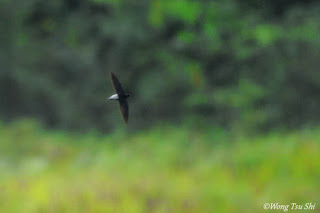This posting is about Mahua Waterfall and the birds we managed to photograph there, it is 6 km detour from Kampung Patau along the Tambunan Ranau road. (Rafflesia Information Centre is along Tambunan Penampang Road).
On recommendation of Sifu Chee Su Ken we stayed at Hostels in Mahua, aptly called Mahua Rainforest Paradise for the night before our return to Tawau the next day. It has good accommodation with electricity supply, in contrast to Gunung Alab Resthouse (the place we used to put up while photographing birds in Rafflesia Reserve) which supplies electricity using its own generator for the earlier part of the night only.
Mahua Waterfall is 1000m above sea level, about the same altitude of Gunung Lucia in Tawau Hills Park and Crocker Range Park near Keningau. It is at this zone that we see the coexistence of both montane and lowland bird species, however, the density of montane/submontane species is more than lowland species in this altitude zone.
Here are some of the pictures taken during the trip.Unless otherwise stated, they all taken at Mahua.
Endemic Mountain Barbet Megalaima monticola, calling from the top of a faraway tree.
Leucistic Pacific Swallow Hirundo tahitica, taken along the way from Tambunan to Tawau, infront of Maliau Basin, you will not miss it if it is flying there with the other swallows.
Leucistic Pacific Swallow Hirundo tahitica, side view of the same bird.
Male Whiskered Treeswift Hemiprocne comata, taken along the way from Tambunan to Tawau, along this stretch of road, there are many Whiskered Treeswifts perch on the telephone wire, oblivious to the passing traffic.
This is Female Whiskered Treeswift along the same stretch of road.
Silver-rumped Spinetail Rhapidura leucopygialis, taken in Maliau Basin entrance, one of my few shots of this species showing its rump.
This is either a female Oriental Cuckoo Cuculus optatus or Himalayan Cuckoo Cuculus satararus from Rafflesia Reserve, I am not sure which as it was silent. For a discussion of these two Cuculus species in Borneo, please see my earlier post here.
Mountain Imperial Pigeon Ducula badia, a lone bird perched at the tip of a bare branch early in the morning, however, many individuals were seen flying overhead later.
Male Grey-chinned Minivet Pericrocotus solaris, common and approachable bird in montane forests.
Female Grey-chinned Minivet.
Female Blue and White Flycatcher Cyanoptila cyanomelana
Grey Wagtail Motacilla cinerea, wintering species commoner in montane habitats in Borneo, Yellow Wagtail Motacilla flava is commoner in the lowlands. An easy way to tell them apart is by looking at the color of the feet, the later has dark legs.
First winter male Mugimaki Flycatcher Ficedula mugimaki, my last lifer for 2013, my number 393 bird photographed in Borneo. This is another migrant that prefers montane to lowland forests here.
Black-and-Crimson Oriole Oriolus cruentus, this bird just refused to come lower.
A group of wintering Eyebrowed Thrush Turdus obscurus, they prefer montane and hill forests here during winter.
Hair-crested Drongo Dicrurus hottentottus
Endemic Bornean Treepie Dendrocitta cinerascens,
Checker-throated Woodpecker Picus mentalis, a species found from lowland to montane forests in Borneo.
Endemic Bornean Ibon Oculocincta squamifrons, submontane species.
Grey Wagtail Motacilla cinerea, this individual was foraging downstream of Mahua Waterfall.
Ochraceous Bulbul Criniger ochraceus, commonly seen in montane forests.
Grey-headed Canary-flycatcher Culicicapa ceylonensis, found also in lowland forests in Tawau Hills Park.
Endemic Bornean Whistler Pachycephala hypoxantha, another common inhabitant of montane forests.
Sunda Laughing-thrush Garrulax palliatus.
Grey-throated Babbler Stachyris nigriceps, commonly seen in bird wave in montane forests.
Happy birding.
Photodocument of the wild birds of Borneo.
Standard references for my blog.




















































